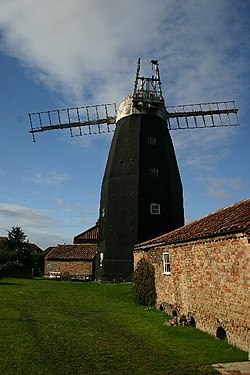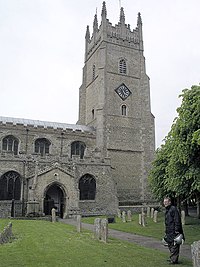Soham
| Soham | |
| Cambridgeshire | |
|---|---|
 Downfield Windmill, Soham | |
| Location | |
| Grid reference: | TL591732 |
| Location: | 52°20’2"N, -0°20’10"E |
| Data | |
| Population: | 9,102 (2001) |
| Post town: | Ely |
| Postcode: | CB7 |
| Dialling code: | 01353 |
| Local Government | |
| Council: | East Cambridgeshire |
| Parliamentary constituency: |
South East Cambridgeshire |
Soham is a large village in Cambridgeshire. It lies on the road (the A142) between Ely and Newmarket, Suffolk. Its population was 9,102 according to the 2001 census.
Parish church

St Andrew's Church[1] dates from the 12th century. In 1102 Hubert de Burgh, Chief Justice of England, granted a certain Ranulph certain lands in trust for the Church of St Andrews. Ranulph is recorded as the first Vicar of Soham and had a hand in designing the Church. Though much of Ranulph's structure remains, most of its structure is later. The tower is the most recent major addition, having been added in the 15th century to replace a fallen crossing tower.
The tower contains ten bells. The back 6 were cast in 1788 with two new trebles and two bells recast in 1808.
St Felix of Burgundy, 'Apostle of the East Angles', founded an abbey near Soham around 630 AD, which lasted until destroyed by the Danes in 870 AD. "Luttingus", an English nobleman, is said to have built a cathedral and palace at Soham around 900 AD, on the site of the present day Church and its adjacent land. Traces of the Saxon Cathedral still exist within the church.
History
Olaudah Equiano or Gustavus Vassa 'The African'
The first black British author and anti-slave activist, Olaudah Equiano, also known as Gustavus Vassa, married local girl, Susannah Cullen, at St Andrew's Church, Soham on 7 April 1792 and the couple lived in the town for a while.
They had two daughters. Anna Maria was born on 16 October 1793 and was baptised in St Andrew's Church on 30 January 1794. Their second child, Joanna Vassa was born on 11 April 1795, and was baptised in St Andrew's Church on 29 April 1795.
William Case Morris 'Dr Barnardo of Argentina'
The most famous son of Soham was William Case Morris who made his mark many miles away in South America. Born in Soham on 16 February 1864, he and his father left in search of a new life in 1872 after the death of his mother in 1868, finally settling in Argentina in 1874.
William was horrified by the terrible poverty of the street children in Argentina, which led him to found several children's homes in Buenos Aires. They are credited with saving thousands of youngsters from abject poverty and a life on the streets.
Morris returned to Soham shortly before his death on 15 September 1932, and was buried in the Fordham Road cemetery. He is still one of Argentina's best-loved social reformers and is highly regarded; In Buenos Aires he has a statue, and named after him are railway stations, football stadia and William C. Morris, a town near Buenos Aires.
The 'Hogar el Alba' children's homes which are his legacy remain active in Buenos Aires[1], still helping impoverished children.
See also
References
- ↑ http://www.hogarelalba.com.ar/institution/42.html Hogar el Alba website, accessed 18 Sept. 2009
Outside links
- Soham On-Line (used as a reference)
- Soham Town Council
- Soham Town Forum
- Soham Community History Museum
- Soham Community Archive